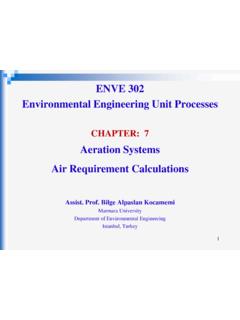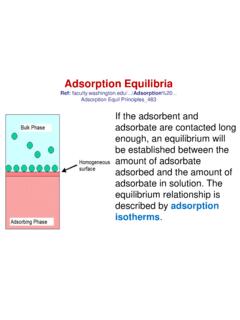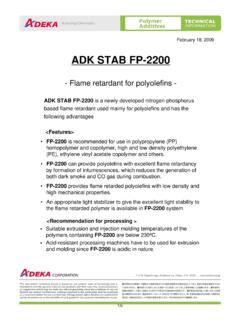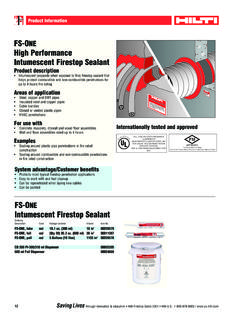Transcription of Principal wastewater constituents Treatment methods for ...
1 ENVE 302 Environmental Engineering Unit Processes Assist. Prof. Bilge Alpaslan Kocamemi Marmara University Department of Environmental Engineering Istanbul, Turkey CHAPTER: 1 Principal wastewater constituents Treatment methods for wastewater wastewater Industrial ww Municipal (domestic) ww Characteristics of industrial ww vary from industry to industry Industrial wastewater with characteristics compatible with municipal ww is often discharged to municipal sewers. However, many industrial ww require pre- Treatment to remove non-compatible substances prior to discharge into municipal system wastewater wastewater flow Lcd 750 460 240 Ref: Metcalf & Eddy, 2004 Typical Composition of Domestic wastewater constituents of wastewater Physical Solids Turbidity Color Temperature Density Conductivity Chemical Inorganic Nutrients(N,P) Metals Gases pH Chloride Sulfur Alkalinity Organic Aggregate organic constituents (comprising a number of organic constituents with similar characteristics that can not be distinguished separately.)
2 Individual compounds VOCs, phenols, pesticides. Biological Microorganisms Pathogenic organisms Typical domestic ww 40-60% protein 25-50% carbonhydrate 8-12% oil-fat. Ref: Metcalf & Eddy, 2004 Classification of Solids Ref: Metcalf & Eddy, 2004 Measurement of Solids Characterization of Organic Content BOD (Biochemical Oxygen Demand) COD (Chemical Oxygen Demand) TOC (Total Organic Carbon) ThOD (Theoretical Oxygen Demand) UV absorbing organic constituents BOD (Biochemical Oxygen Demand) Measurement of the dissolved oxygen used by microorganisms in the biochemical oxidation of organic matter CBOD (carbonecous BOD): oxygen demand exerted by the oxidizable carbon in the sample NBOD (nitrogenous BOD): oxygen demand associated with the oxidation of ammonia to nitrate (nitrification) Ref: Metcalf & Eddy, 2004 cBOD & nBOD However; if a sufficient number of nitrifying bacteria is present initially interference of cBOD measurement caused by nitrifiers can be significant To supress nitrification.
3 Methylene blue ATU (Allythiourea) Reproductive rate of nitrifiers is slow it normally takes from 6-10 days for them to reach significant numbers to exert a measurable oxygen demand COD (Chemical Oxygen Demand) Measure the oxygen equivalent of the organic material in wastewater that can be oxidized chemically using dichromate in an acid solution 3422272cbandCr2cNHOH2c3d8anCOH)cd8(OdCrN OHC2c3b6a3n2dwhere organic substances which are difficult to oxidize biologically ( lignin) can be oxidized chemically. substances that are oxidized by dichromate ( sulfide,sulfite, ferrous ion) 3. Certain organic substances may be toxic to microorganisms used in the BOD test. Why not cBOD is equal to COD ? Typical BOD/COD of untreated domestic wastewater : If BOD/COD ratio is : Waste is considered to be easily treatable by biological means If BOD/COD ratio is : Organics in wastewater may be refractory Organics in wastewater are degradable.
4 However, another substance in wastewater leads to inhibition of bacteria that uses organic matter Bacteria is not acclimated to wastewater TOC (Total Organic Carbon) Done instrumentally (5-10 min) to determine total organic carbon in aqueous sample (mg C/L) This test measures all C as CO2 Inorganic C (CO2, HCO3) present in wastewater must be removed prior to analysis by acidification and aeration of sample prior to analysis Typical BOD/TOC of untreated domestic wastewater O2/mg C ThOD (Theoretical Oxygen Demand) ThOD of a wastewater is calculated as the oxygen required to oxidize the organics to end products Example : glycine CH2(NH2)COOH CH2(NH2)COOH + 3/2 O2 NH3 + 2 CO2 + H2O For nitrogenous oxygen demand : NH3 + 3/2 O2 HNO2 + H2O HNO2 + 1/2 O2 HNO3 + H2O ThOD = (3/2 + 3/2 + 1/2) mol O2 / mol glycine UV Absorbing constituents Humic substances Lignin Strongly absorb UV Tannin Various aromatic compounds UV absorption has been used as a surrogate measure for the organic compounds cited above UV wavelength = 200 400 nm (254 nm most common) rbsCOD (soluble) : quickly assimilated by biomass sbCOD (particulate) : must be firts dissolved by extracellular enzymes assimilated much slower rate nbVSS nonbiodegredable particulate (nbpCOD): since it is organic material, it will also contribute VSS.
5 Influent wastewater will also contain non-voltile suspended solids that add to the MLSS concentration Inert TSS (iTSS) iTSS=TSSinf VSSeff Ref: Metcalf & Eddy, 2004 COD Fractionation Determination of soluble COD Filtration through m membrane analysis of the for COD Determination of bCOD BOD test data is necessary bCOD consumed in BOD test = oxygen consumed (uBOD) + oxygen equivalent of remaining cell debris bCOD = uBOD + fd Yh bCOD Yield coeff. g VSS/g COD used Fraction of cell mass remainig as cell debris (g/g) bCOD/BOD= (uBOD/BOD) / ( fd Yh) For typical domestic ww: fd= , Yh= , uBOD/BOD= bCOD/BOD= Not all of the bCOD is oxidized in the BOD test Some of the bCOD is converted into biomass uBOD < bCOD Determination of rbCOD Biological Response Test for rbCOD Pre-aerated wastewater mixed with acclimated sludge DO concentrations with respect to time is measured Slope of DO vs time graph (mg/L DO) / time = OUR (Oxygen Uptake Rate) When DO decreases to about 3mg/L , vigorous aeration is applied to elevate DO conc.
6 To 5 to 6 mg/L. So another OUR measurement can begin WWWWASCOD,HAVVVY1 OrbCODVAS=volume of activated sludge used in the test (mL) Vww=volume of ww (mL) OA=oxygen consumed in area A (mg/L) YH,COD=synthesis yield coeff for heterotrophic becteria (g cell COD/g COD used) Biological Response Test for rbCOD (continue) b) Physical seperation technique for rbCOD (Mammais et al, 1993) may not give the exact results as the rbCOD concentration determination by respirometry, but it provides a reasonable estimate used widely because of its simplicity The procedure is based on the assumption that suspended solids and colloidal material can be captured effectively and removed by flocculation with a zinc hydroxide precipitate to leave only truly dissolved organic material after filtration Procedure: 1 ml of a 100 g/L ZnSO4 solution is added to 100 ml of sample with vigorous mixing for 1 min The pH is raised to about using 6 M NaOH with 5-10 min of gentle mixing for floc formation The sample is settled for 10-20 min and the supernatant is withdrawn and filtered using a m membrane filter The filtrate is analyzed for COD conc.
7 RbCOD rbCOD = CODww COD act. sludge treated sample Physical seperation technique for rbCOD (continue) sCOD= soluble COD sBOD= soluble BOD Filtration through m membrane filter Non biodegradable VSS VSSpCODbpCOD1nbVSSsCODCODsBODBODBODbCODp CODbpCODS ummary COD= bCOD+nbCOD bCOD= BOD (for domestic wastewater ) nbCOD= sCODe+nbpCOD bCOD= sbCOD+rbCOD Nitrogen Forms in wastewater Ammonia (NH3) Ammonium (NH4) Nitrite (NO2-) Nitrate (NO3-) Organic nitrogen Total Nitrogen = Organic N+NH3+NH4+NO2-+NO3- Total Kjeldahl Nitrogen (TKN) = Organic N+NH3+NH4 NH4 NH3 + H+ pH>7 rxn. shifts right pH<7 rxn. shifts left Nitrogen Transformations in Biological Treatment Processes about 60-70% of the influent TKN readily available for bacterial synthesis and nitrification. will be removed more slowly than soluble degradable organic nitrogen because a hydrolysis reaction is necessary first will be captured in the activated sludge floc and exit in waste sludge will be found in the secondary clarifier effluent (<3% of influent TKN) Ref: Metcalf & Eddy, 2004 Ref: Metcalf & Eddy, 2004 Phosphorus Orthophosphate (PO4-3 , HPO4-2 , H2PO4- , H3PO4) available for biological metabolism without further breakdown Polyphosphate Undergo hydrolysis (quite slow) and convert to orthophosphate form Organic phosphate minor importance in most domestic wastes Chloride Human excreta contains 6g chloride /person /day Conventional methods of waste Treatment do not remove Cl- Higher tan usual Cl- conc.
8 Indication that a body water is being used for waste disposal Infiltration of grounwater into sewers adjacent to ea water Sulfate Occurs naturally in most water supplies and is present in wastewater as well Crown corrosion problem in sewers: Org. Matter + SO4-2 S-2 + H2O +CO2 S-2+2H+ H2S (under anaerobic conditions) H2S collected at the crown of sewer not flowing full H2SO4 (seriously threaten structural integrity of pipe Color Give rough information about age of wastewater Fresh wastewater light brownish gray color As the travel time in the collection system increases more anaerobic conditions develop color of wastewater sequentially changes gray dark gray black (SEPTIC) Odor Gases found in untreated wastewater N2, O2, CO2 (from in all waters exposed atmosphere) H2S, NH3, CH4 (from the decomposition of organic matter ) H2S: from the anaerobic decomposition of organic matter Org.)
9 Matter + SO4-2 S-2 + H2O +CO2 S-2+2H+ H2S Odor :rotten egg Colorless Inflammable H2S poisoning is one of the leading cause of accidents in WWTP 5ppm moderate odor 10ppm eye irritation begins 30ppm strong,unpleasent odor of rotten egg 100 ppm loss of smell >300ppm unconsciousness, death Mercaptan formed during anaerobic decomposition of organic matter may cause odor more offensive than that of H2S Methane(CH4) Principal by-product from the anaerobic decombosition of organic matter Colorless, odorless, combustible hydrocarbon with high flue value Explosion risk Large quantities are not encountered in untreated ww PLANT EMPLOYEES SHOULD BE INSTRUCTED IN SAFETY MEASURES WHILE WORKING IN AND ABOUT STRUCTURES WHERE H2S AND CH4 MAY BE PRESENT VENTILATION, GAS SENSORS, ALARM SYSTEMS Temperature Temperature of domestic wastewater is commonly higher than that of local water supply, because of the addition of warm water from households Alkalinity Domestic wastewater is normally alkaline receiving its alkalinity from the water supply, the groundwater, the materials added during domestic use Discharged from residental dwellings, groundwater infiltration, commercial and industrial discharge Metals term used for fats, oils.
10 Waxes Oil and Grease Surfactants Surface active agents Large organic molecules that are slightly soluble in water Cause foaming in ww Treatment plants During aeration of ww these compounds collect on the surface of the air bubble and thus create a very stable foam Cause foaming in the surface water into which ww is discharged Before 1965 ABS (Alkly-benzene-sulfonate) resistant to breakdown by biological means After 1965 LAS (linear alkly-sulfonate biodegradable Come primarily from synthetic detergents Surfactants (continue) constituent Reason of Importance Unit operation and process used to remove Suspended Solids Can lead to development of sludge deposits and anaerobic conditions when untreated wastewater is discharged Screening Grit Removal Sedimentation Flotation Chemical precipitation Filtration Biodegradable organics If discharged untreated to the environment their biological stabilization can lead to the depletion of natural oxygen resources and to the development of septic conditions Aerobic suspended growth variations Aerobic attached growth variations Anaerobic suspended growth variations Lagoon variations Chemical oxidation Advanced oxidation Membrane filtration Principal constituents OF CONCERN IN MUNICIPAL wastewater Treatment constituent Reason of Importance Unit operation and process used to remove Nutrients (Nutrient and phosphorus))









